26
The Tropical Fruit Forum
Uniting Growers Worldwide!
News:
We are looking for Facebook editors for the forum's Facebook page.
This section allows you to view all posts made by this member. Note that you can only see posts made in areas you currently have access to.
27
Cold Hardy Citrus / Hardy citrus on other rootstocks
« on: April 06, 2019, 10:02:12 PM »
We know about hardy citrus on trifoliate and Flying Dragon trifoliate rootstock, but how much do we know about hardy citrus on other trifoliate hybrid rootstocks?
How do you think hardy citrus would do on Tai-tri or US 852 (Changsha x trifoliate) ?
How do you think hardy citrus would do on Tai-tri or US 852 (Changsha x trifoliate) ?
29
Citrus Buy, Sell, & Trade / Ugli fruit seedlings available
« on: March 22, 2019, 07:45:56 PM »
Jamaican Ugli fruit small seedlings available, grown from seed
can't ship to citrus states or Europe
free, but you pay for shipping
seedlings are not in the best shape but should survive if you give them proper care
can't ship to citrus states or Europe
free, but you pay for shipping
seedlings are not in the best shape but should survive if you give them proper care
30
Citrus General Discussion / Shasta Gold mandarin
« on: February 13, 2019, 05:41:24 AM »
I've just been enjoying a few Shasta Gold mandarins. I have to say, this is one of the best varieties, in my personal opinion, and I'm not a fan of most mandarin varieties. I'd probably rate this my 2nd or 3rd favorite mandarin variety after Satsuma and Kishu.
The fruit size is very big, it's easy to peel, the skin is a deeper reddish-orange color. The fruits have a characteristic flattened shape. The flavor is very tangy, aromatic in the way of an orange, a bit tart and very flavorful.
I'd say the level of aromatic aroma is almost as high as a Page mandarin, while the type of aroma is maybe somewhere in between a Page mandarin and an orange.
These are very nice to snack on.
I've read some comments from a few people saying that Shasta Gold has an off-taste, but I don't think this is so. Might just be a personal preference thing.
Shasta Gold originated from a cross between Temple Orange and a tetraploid version of Dancy mandarin, which was subsequently crossed with Encore mandarin. (Temple orange is actually a tangor)
Shasta Gold is a triploid variety, which explains its seedlessness (there might only be 1 seed out of every 5 fruits).
I've tasted Tahoe Gold and didn't think it was as good, not really anything special.
Just for additional comparison, I'm not a big fan of Gold Nugget, despite all the hype and some people claiming they're really good.
I've tried growing two Shasta Gold plants from seed but the seedlings from this variety seem to be very week and don't grow very well for some reason.
The fruit size is very big, it's easy to peel, the skin is a deeper reddish-orange color. The fruits have a characteristic flattened shape. The flavor is very tangy, aromatic in the way of an orange, a bit tart and very flavorful.
I'd say the level of aromatic aroma is almost as high as a Page mandarin, while the type of aroma is maybe somewhere in between a Page mandarin and an orange.
These are very nice to snack on.
I've read some comments from a few people saying that Shasta Gold has an off-taste, but I don't think this is so. Might just be a personal preference thing.
Shasta Gold originated from a cross between Temple Orange and a tetraploid version of Dancy mandarin, which was subsequently crossed with Encore mandarin. (Temple orange is actually a tangor)
Shasta Gold is a triploid variety, which explains its seedlessness (there might only be 1 seed out of every 5 fruits).
I've tasted Tahoe Gold and didn't think it was as good, not really anything special.
Just for additional comparison, I'm not a big fan of Gold Nugget, despite all the hype and some people claiming they're really good.
I've tried growing two Shasta Gold plants from seed but the seedlings from this variety seem to be very week and don't grow very well for some reason.
31
Citrus General Discussion / How to use Yuzu (and other culinary citrus varieties)
« on: February 02, 2019, 12:48:36 AM »
This topic came up in another thread, and I'd like to discuss how to use Yuzu.
First I want to say Yuzu is a wonderful unique citrus, with a unique flavor. But those who do not know how to properly use Yuzu may not be able to appreciate it.
Yuzu is definitely not a fruit for direct out of hand eating.
I slice up a Yuzu, remove all the seeds (there's a lot of them but it's not difficult because the seeds are so big), then chop up the fruits further and cook them into a citrus marmalade sauce to spread over fish. With Yuzu there's no need to remove the rinds, indeed there wouldn't be that much useable part of the fruit left if you did so. The rinds have a lot of flavor, and are a lot more tender, less bitter, and more edible than lemon or orange rinds would be.
This isn't unusual. Sometimes mandarin peels and even orange peels are used in stir fries in Chinese cuisine, mostly to impart flavor but it won't hurt if you eat some of it. However the rinds of Yuzu are much more edible.
Not quite like the kumquats but I would say they are only a little less tender than mandarinquats.
I actually enjoy taking a few table out of the peel of a fresh Yuzu.
Yuzu is most typically used for flavoring. It's really in good in Japanese-style ponzu sauces for dipping.
Typically the entire fruits are crushed, with the juice and essential oils from the rind collected. (It would probably be even better flavor wise to remove the seeds first before crushing but that would add more work)
There's not a huge amount of juice inside a Yuzu, and this is in large part because there are so many large seeds.
Yuzu kosho is great on egg rolls or omelettes. Yuzu is also good in salad dressings.
Also good for soba (buckwheat) noodles or Japanese noodle bowls with fish.
Lemon juice can substitute for Yuzu in most recipes but the flavor is just not the same.
Also there are some great recipes for candied Yuzu peel, which are much like candied citron.
You could even bake these into a cake, and I have a great tasting recipe for Yuzu blueberry muffins.
If you're still not sold on Yuzu, you might see this video for inspiration:
https://www.youtube.com/watch?v=jdUq2AVLEn8
I'm sure Yuzu has (or could have) all sorts of other culinary uses as well.
First I want to say Yuzu is a wonderful unique citrus, with a unique flavor. But those who do not know how to properly use Yuzu may not be able to appreciate it.
I never found a good use for yuzu & cut both my trees down.
And you never bothered to do any research to see how Yuzu fruit are used?
Sure I did, and still couldn't find a use for them. I'm not going to float them in the bath & as far as a good tasting citrus, it isn't.
Yuzu is definitely not a fruit for direct out of hand eating.
I slice up a Yuzu, remove all the seeds (there's a lot of them but it's not difficult because the seeds are so big), then chop up the fruits further and cook them into a citrus marmalade sauce to spread over fish. With Yuzu there's no need to remove the rinds, indeed there wouldn't be that much useable part of the fruit left if you did so. The rinds have a lot of flavor, and are a lot more tender, less bitter, and more edible than lemon or orange rinds would be.
This isn't unusual. Sometimes mandarin peels and even orange peels are used in stir fries in Chinese cuisine, mostly to impart flavor but it won't hurt if you eat some of it. However the rinds of Yuzu are much more edible.
Not quite like the kumquats but I would say they are only a little less tender than mandarinquats.
I actually enjoy taking a few table out of the peel of a fresh Yuzu.
Yuzu is most typically used for flavoring. It's really in good in Japanese-style ponzu sauces for dipping.
Typically the entire fruits are crushed, with the juice and essential oils from the rind collected. (It would probably be even better flavor wise to remove the seeds first before crushing but that would add more work)
There's not a huge amount of juice inside a Yuzu, and this is in large part because there are so many large seeds.
Yuzu kosho is great on egg rolls or omelettes. Yuzu is also good in salad dressings.
Also good for soba (buckwheat) noodles or Japanese noodle bowls with fish.
Lemon juice can substitute for Yuzu in most recipes but the flavor is just not the same.
Also there are some great recipes for candied Yuzu peel, which are much like candied citron.
You could even bake these into a cake, and I have a great tasting recipe for Yuzu blueberry muffins.
If you're still not sold on Yuzu, you might see this video for inspiration:
https://www.youtube.com/watch?v=jdUq2AVLEn8
I'm sure Yuzu has (or could have) all sorts of other culinary uses as well.
32
Cold Hardy Citrus / Might Kaffir Lime be hardier than we think?
« on: February 01, 2019, 04:30:59 PM »
There are a lot of people in colder climates who would like to grow a lime tree. Unfortunately for them, and something almost none of them realize, limes are the very least hardy out of all the citrus groups commonly sold in a supermarket. If you wanted to try pushing the boundaries and see if a citrus tree might be able to survive in your marginal climate, a lime tree would be the very last thing you'd want to try.
But that being said, Kaffir lime is not actually a true lime.
Regular limes descend from an ancestor called Citrus micrantha, which has very little tolerance to cold. Kaffir limes, on the other hand, descend from a different ancestral species, Khasi papeda (Citrus latipes ) which grows a bit further inland at a bit higher elevation.
If you look at the leaves of Kaffir lime, they have huge winged petioles that are very reminiscent of Citrus Ichangensis (a notoriously cold hardy species). I don't know but this suggests there might be a distant relation. (Now of course this doesn't prove cold hardiness. Citrus micrantha itself also has fairly large winged petioles and is the last thing from cold hardy.)
(Note: I don't believe the C. latipes in the UCR collection is fully representative of the species in the wild, in terms of leaf shape)
This is a botanical drawing of Kaffir lime, note the leaf shape:
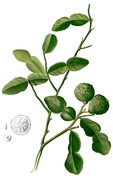
[another little thing I'll point out about the difference between C. micrantha and C. latipes is that C. micrantha has off the charts levels of furanocoumarins, which no doubt explains why lime juice is so photosensitizing; whereas Kaffir lime has only extremely low levels by comparison, based on this one fact alone one could infer different ancestry]
I've seen various different sources, some listing Kaffir lime as zone 10 (like most ordinary citrus) and some indicating it can survive down to zone 9.
The very fact it could be grown in zone 9 would indicate it is much hardier than ordinary limes.
Kaffir lime is rather a less common variety, so I'd imagine there hasn't been a lot of experimentation investigating whether it can survive in marginal climates. Probably most everyone just assumes it is going to be like any other ordinary citrus.
I suspect however that Kaffir lime might have a similar level of cold hardiness to Meyer lemon.
(And if that's the case there is a possibility it might be able to survive outside in urban areas of Vancouver, B.C., but I'm getting ahead of myself)
This entire thread is very speculative.
A comment left in a discussion about Kaffir lime:
________________________________________________
December 21, 2010, jbwaters from Dallas, TX wrote:
I love this plant. I have had one in a pot for about 12 years now and it is still thriving. Mine fruits and I have been extremely successful with starting new ones from seeds -- i plant them directly from the fruit into moist soil -- about 95% sprouted and are either in the ground or given as gifts. In the summer, I have mine in dappled to direct sun until late afternoon and have positioned it so that I can see the Giant Swallowtails laying their eggs on it from my kitchen window-- their ceterpillars look like bird droppings. My tree is easily big enough to share with them. It doesn't seems to like our Texas sun as much as my Satsuma Orange does.
And despite the fact that the kaffir lime shouldn't survive freezing temps, I planted one in a slightly protected area near my house and despite records snows in Dallas, TX last year (12 inches over night that lasted with well below freezing temps for several days), the kaffir lime tree came back! They got about 2 feet tall with very little water or attention. So this year I planted more in the ground to see how they would do. My fruiting tree stays in the pot though as she is a rare thing to find and stays in the greenhouse once we hit 40 degrees until we are reliably in the 50s.
________________________________________________
https://davesgarden.com/guides/pf/go/67460/#b
The leaves of Kaffir lime are very useful for cooking with in Southeast Asian cuisine, used much the same way that bay leaves are.
(Unlike the leaves of other citrus, kaffir lime leaves are very mild and don't have the characteristic harsh astringency of other citrus leaves, which is probably reflective of its papeda ancestry)
The fruits, on the other hand, are much lower quality than normal limes, though not terrible (they just have somewhat less of the characteristic lime flavor, and a very slight amount of bitterness), but the fruits are sometimes valued for the zest that comes from the rinds. The zest is better than that which would come from regular limes.
But that being said, Kaffir lime is not actually a true lime.
Regular limes descend from an ancestor called Citrus micrantha, which has very little tolerance to cold. Kaffir limes, on the other hand, descend from a different ancestral species, Khasi papeda (Citrus latipes ) which grows a bit further inland at a bit higher elevation.
Quote
This citrus species, C. latipes (Swingle) Yu. Tanaka is locally called as Soh Kymphor by the Khasi tribe of Meghalaya. This fruit is bitter sour in taste and commonly consumed raw. But, in a few local Khasi villages of Laitjem and Sadew, this fruit is eaten between meals, usually blended with finely cut tender leaves of mustard or radish with chillies, sugar and salt to taste.https://explorers.zizira.com/wild-citrus-fruits-meghalaya-uses/
Here are a few traditional uses of this plant:
The leaves of this citrus plant are boiled in water until the water turns green. Then this water is used for bathing, to relieve body aches, fever, common cold and headache.
The citrus fruit is peeled and boiled in water, then it is cooled and strained using muslin cloth and stored. This decoction is used by diluting it with water and consumed orally to cure stomach disorders, constipation and skin problems. It is also applied to heal chapped and dry skin.
The juice of the fruit is mixed with mustard oil and used as balm on the forehead and the nose during a fever or cold, to lower the body temperature. It also acts as an antiseptic when applied to cuts and wounds.
If you look at the leaves of Kaffir lime, they have huge winged petioles that are very reminiscent of Citrus Ichangensis (a notoriously cold hardy species). I don't know but this suggests there might be a distant relation. (Now of course this doesn't prove cold hardiness. Citrus micrantha itself also has fairly large winged petioles and is the last thing from cold hardy.)
(Note: I don't believe the C. latipes in the UCR collection is fully representative of the species in the wild, in terms of leaf shape)
This is a botanical drawing of Kaffir lime, note the leaf shape:

[another little thing I'll point out about the difference between C. micrantha and C. latipes is that C. micrantha has off the charts levels of furanocoumarins, which no doubt explains why lime juice is so photosensitizing; whereas Kaffir lime has only extremely low levels by comparison, based on this one fact alone one could infer different ancestry]
I've seen various different sources, some listing Kaffir lime as zone 10 (like most ordinary citrus) and some indicating it can survive down to zone 9.
The very fact it could be grown in zone 9 would indicate it is much hardier than ordinary limes.
Kaffir lime is rather a less common variety, so I'd imagine there hasn't been a lot of experimentation investigating whether it can survive in marginal climates. Probably most everyone just assumes it is going to be like any other ordinary citrus.
I suspect however that Kaffir lime might have a similar level of cold hardiness to Meyer lemon.
(And if that's the case there is a possibility it might be able to survive outside in urban areas of Vancouver, B.C., but I'm getting ahead of myself)
This entire thread is very speculative.
A comment left in a discussion about Kaffir lime:
________________________________________________
December 21, 2010, jbwaters from Dallas, TX wrote:
I love this plant. I have had one in a pot for about 12 years now and it is still thriving. Mine fruits and I have been extremely successful with starting new ones from seeds -- i plant them directly from the fruit into moist soil -- about 95% sprouted and are either in the ground or given as gifts. In the summer, I have mine in dappled to direct sun until late afternoon and have positioned it so that I can see the Giant Swallowtails laying their eggs on it from my kitchen window-- their ceterpillars look like bird droppings. My tree is easily big enough to share with them. It doesn't seems to like our Texas sun as much as my Satsuma Orange does.
And despite the fact that the kaffir lime shouldn't survive freezing temps, I planted one in a slightly protected area near my house and despite records snows in Dallas, TX last year (12 inches over night that lasted with well below freezing temps for several days), the kaffir lime tree came back! They got about 2 feet tall with very little water or attention. So this year I planted more in the ground to see how they would do. My fruiting tree stays in the pot though as she is a rare thing to find and stays in the greenhouse once we hit 40 degrees until we are reliably in the 50s.
________________________________________________
https://davesgarden.com/guides/pf/go/67460/#b
The leaves of Kaffir lime are very useful for cooking with in Southeast Asian cuisine, used much the same way that bay leaves are.
(Unlike the leaves of other citrus, kaffir lime leaves are very mild and don't have the characteristic harsh astringency of other citrus leaves, which is probably reflective of its papeda ancestry)
The fruits, on the other hand, are much lower quality than normal limes, though not terrible (they just have somewhat less of the characteristic lime flavor, and a very slight amount of bitterness), but the fruits are sometimes valued for the zest that comes from the rinds. The zest is better than that which would come from regular limes.
33
Cold Hardy Citrus / Some rare variety hardy seedlings
« on: January 31, 2019, 11:27:19 PM »
These are some seedlings I'm growing:
Kaffir lime, Yuzu, Ichangquat, US 852, one of them is a Thomasville Citrangequat and one is an N1tri

These are a Ventura Lemandarin (back) and Dimicelli seedlings that Eyeckr gave me. They're putting on new growth.

They're inside a grow tent.
(I measured the temperature difference and it's 7 degrees (F) warmer inside the enclosure than inside the room it is in)
Kaffir lime, Yuzu, Ichangquat, US 852, one of them is a Thomasville Citrangequat and one is an N1tri

These are a Ventura Lemandarin (back) and Dimicelli seedlings that Eyeckr gave me. They're putting on new growth.

They're inside a grow tent.
(I measured the temperature difference and it's 7 degrees (F) warmer inside the enclosure than inside the room it is in)
34
Citrus General Discussion / Enjoying some Nova Lee mandarins
« on: January 31, 2019, 10:22:56 PM »
Enjoying some Nova Lee mandarins.
The flavor is reminiscent of Page mandarins, but the flavor is a bit more subtle. Makes for a good dessert mandarin.
It's not too difficult to peel, though not quite as easy to peel as some of the other "zipper skin" mandarins.
Seems to be completely seedless.
Altogether, I'd say this is one of the better varieties of mandarin. One to include in your collection if you're only growing four or five varieties.
Something about it almost sort of reminds me of a dekopon.
The flavor is reminiscent of Page mandarins, but the flavor is a bit more subtle. Makes for a good dessert mandarin.
It's not too difficult to peel, though not quite as easy to peel as some of the other "zipper skin" mandarins.
Seems to be completely seedless.
Altogether, I'd say this is one of the better varieties of mandarin. One to include in your collection if you're only growing four or five varieties.
Something about it almost sort of reminds me of a dekopon.
35
Cold Hardy Citrus / Citrange growing in Philadelphia
« on: January 31, 2019, 09:12:24 PM »
These are some pictures of a Citrange growing in the Philadelphia area, outside unprotected.
Supposedly this variety is actually a cross between a Mandarin and a Citrange.
It was planted in 2003. It died back one winter a few years ago and has probably since died completely in the severe 2017/2018 winter.
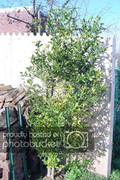
It's semi-evergreen, meaning only maybe 20 percent of the leaves yellow in fall.
There are thorns in there too. Some of the leaves appear to be trifoliate.
The first fruits appeared in 2007, and there were three fruits that year. The next year there were twelve, and thirteen fruits the year after that.


The fruits even get a chance to ripen to nice glossy orange. They contain plenty of seeds.
Unfortunately they taste bitter and sour, not very edible.

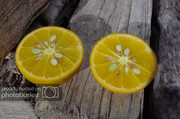
This is just a repost of an old thread from another forum:
http://www.philadelphiaspeaks.com/threads/my-citrandarin-tree.7372/#post-121801
I don't know if there's any chance this tree could have been a Dimicelli.
The original post said his tree was a cross between a Mandarin and Citrange.
I have a Dimicelli seedling and from the research I've been able to dig up about it it supposedly came from a cross between Temple orange and poncirus, which was then crossed with a Clementine.
Supposedly this variety is actually a cross between a Mandarin and a Citrange.
It was planted in 2003. It died back one winter a few years ago and has probably since died completely in the severe 2017/2018 winter.

It's semi-evergreen, meaning only maybe 20 percent of the leaves yellow in fall.
There are thorns in there too. Some of the leaves appear to be trifoliate.
The first fruits appeared in 2007, and there were three fruits that year. The next year there were twelve, and thirteen fruits the year after that.


The fruits even get a chance to ripen to nice glossy orange. They contain plenty of seeds.
Unfortunately they taste bitter and sour, not very edible.


This is just a repost of an old thread from another forum:
http://www.philadelphiaspeaks.com/threads/my-citrandarin-tree.7372/#post-121801
I don't know if there's any chance this tree could have been a Dimicelli.
The original post said his tree was a cross between a Mandarin and Citrange.
I have a Dimicelli seedling and from the research I've been able to dig up about it it supposedly came from a cross between Temple orange and poncirus, which was then crossed with a Clementine.
36
Cold Hardy Citrus / Hardy citrus growing in Switzerland
« on: January 21, 2019, 12:13:17 AM »
Triengen is Northwest of Lucerne, in Northern Switzerland
Thomasville Citrangequat on left, Keraji bushy one on right
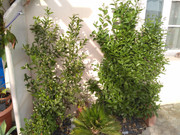
They are both up against a wall, and it looks like they can be covered during the Winter.
closer view of Thomasville Citrangequat
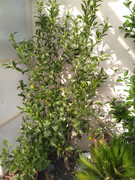
Yuzu
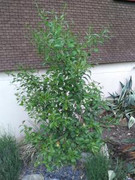
Swingle Citrumelo in Schaffhausen, Northern Switzerland, North of Zurich
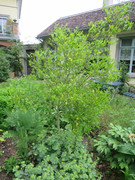
It was planted in the ground two and a half years before this picture was taken and had not been protected, relatively exposed. Suffered light leaf damage the second winter but recovered again very strong, but had not yet had flowers.
Ichang papeda in Erfstadt, just outside of Cologne, Germany (still zone 8a)
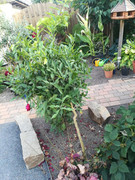
German language forum: http://www.exotenundpalmen.de/t1228f5-quot-winterharte-quot-essbare-citrus.html
(I don't think hardy citrus normally grows well in these areas, but can if it's in an ideal or protected spot)
Thomasville Citrangequat on left, Keraji bushy one on right

They are both up against a wall, and it looks like they can be covered during the Winter.
closer view of Thomasville Citrangequat

Yuzu

Swingle Citrumelo in Schaffhausen, Northern Switzerland, North of Zurich

It was planted in the ground two and a half years before this picture was taken and had not been protected, relatively exposed. Suffered light leaf damage the second winter but recovered again very strong, but had not yet had flowers.
Ichang papeda in Erfstadt, just outside of Cologne, Germany (still zone 8a)

German language forum: http://www.exotenundpalmen.de/t1228f5-quot-winterharte-quot-essbare-citrus.html
(I don't think hardy citrus normally grows well in these areas, but can if it's in an ideal or protected spot)
37
Cold Hardy Citrus / A few super-hardy C. ichangensis hybrid seedlings
« on: January 19, 2019, 02:06:41 AM »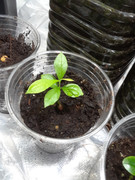
Citrus ichangensis x Poncirus trifoliata (N1tri) seedling
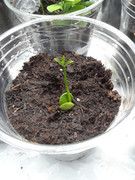
kumquat x C. ichangensis (Ichangquat) seedling
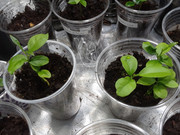
some Yuzu (C. junos) seedlings
Yuzu has a really close genetic relationship with C. ichangensis, it may even be descended from it (possibly as a result of genetric introgression from another C. reticula-like citrus species). Some see Yuzu as a C. ichangensis hybrid (constituting an Ichandarin), although it's certainly not a direct hybrid. Yuzu isn't quite as cold hardy as C. ichangensis, maybe but it is a more vigorous and fast grower and can easily recover from damage. Also the leaves of C. ichangensis smell nothing like Yuzu, although they do share a same distict "deepness". Otherwise the smell of C. ichangensis leaves are very mild (maybe a bit like Kaffir lime leaf) and a bit lemony. The leaves of Yuzu are practically like petitgrain (strong, green, harsh, petitgrain is made from the leaves of bergamot citrus). The fruits of Yuzu are very fragrant though (like a mixture of sour orange, Satsuma mandarin, lemon, and maybe a hint of grapefruit sweetness, and also it is a pungently deep spicy smell).
38
Citrus General Discussion / Check out the winged petioles on this pomelo seedling
« on: January 19, 2019, 01:23:19 AM »
This was grown from a seed from a pomelo I got at the supermarket. This pomelo variety definitely wasn't the ordinary Chandler. The smaller flattened shape of the fruit made me think it was probably Reinking (though I can't be absolutely sure).
Check out the size of those winged petioles!

I don't think I've seen a pomelo with petioles that big before.
Almost reminds me of Ichang papeda.
Check out the size of those winged petioles!

I don't think I've seen a pomelo with petioles that big before.
Almost reminds me of Ichang papeda.
39
Cold Hardy Citrus / Graft chimeras and hardy citrus
« on: January 16, 2019, 10:57:18 AM »
How much do we know about graft chimeras and hardy citrus?
Graft chimeras are a sort of hybrid, but not a genetic one, between two different species that resulted through grafting, typically from growth offshoot coming out of a graft union area and then separately propagated. The graft chimera is comprised of a mixture of cells between the two citrus types.
There are different types of graft chimeras. The most homogeneous ones, and the ones of most interest are periclinal chimeras, which typically involve a single layer of cells distributed throughout the growth of the plant.
I'm also experimenting with joining together different seedlings together at the earliest stage of their development, so that the seedling sprout consists of a mix of cells from two sources. (This takes some very fine precision and a good eye)
How much hardiness can a cold hardy variety confer to another normal citrus variety when they are part of a chimera together?
Could this be a viable strategy for developing new cold hardy citrus?
From what I've seen, many obscure citrus varieties that are believed to have originated as a graft chimera have not actually been confirmed as being so, so it's not truly known with certainty.
The only way to be sure is if there's obvious phenotypical differences in different parts of the tree, or on different parts of the fruit, but in that case its not a very homogenous chimera, and not a periclinal type of one, which would be expected to give the best hardiness because the cells are more evenly distributed throughout the plant.
Say for instance we had a Satsuma graft chimera together with a Satsuma-trifoliate (citrandarin) hybrid.
The Satsuma-trifoliate hybrid within the chimera system could be a triploid with only one of its three sets of chromosomes coming from trifoliate.*
That could potentially make the resulting chimera nearly indistinguishable from normal Satsuma.
* (This could come about through hybridizing a tetraploid Satsuma with a normal diploid trifoliate, or the pollen may have been unreduced coming from the Satsuma, or the female parent being used could have been a "seedless" triploid, and so any rare seeds that did manage to form would be much more likely to have originated from an unreduced female gamete, since triploid cells that undergo meiosis have a fairly high chance of turning out aneuploid and won't develop. Also, you have to have a non-nucellar citrus variety for the triploid to turn out seedless, otherwise the seeds are still going to form from nucellar tissue even though the zygote failed to develop.)
Prague Citsuma is believed to be a graft hybrid, but it has not yet been positively confirmed with certainty. (A few basic tests were done but were inconclusive)
Graft chimeras are a sort of hybrid, but not a genetic one, between two different species that resulted through grafting, typically from growth offshoot coming out of a graft union area and then separately propagated. The graft chimera is comprised of a mixture of cells between the two citrus types.
There are different types of graft chimeras. The most homogeneous ones, and the ones of most interest are periclinal chimeras, which typically involve a single layer of cells distributed throughout the growth of the plant.
I'm also experimenting with joining together different seedlings together at the earliest stage of their development, so that the seedling sprout consists of a mix of cells from two sources. (This takes some very fine precision and a good eye)
How much hardiness can a cold hardy variety confer to another normal citrus variety when they are part of a chimera together?
Could this be a viable strategy for developing new cold hardy citrus?
From what I've seen, many obscure citrus varieties that are believed to have originated as a graft chimera have not actually been confirmed as being so, so it's not truly known with certainty.
The only way to be sure is if there's obvious phenotypical differences in different parts of the tree, or on different parts of the fruit, but in that case its not a very homogenous chimera, and not a periclinal type of one, which would be expected to give the best hardiness because the cells are more evenly distributed throughout the plant.
Say for instance we had a Satsuma graft chimera together with a Satsuma-trifoliate (citrandarin) hybrid.
The Satsuma-trifoliate hybrid within the chimera system could be a triploid with only one of its three sets of chromosomes coming from trifoliate.*
That could potentially make the resulting chimera nearly indistinguishable from normal Satsuma.
* (This could come about through hybridizing a tetraploid Satsuma with a normal diploid trifoliate, or the pollen may have been unreduced coming from the Satsuma, or the female parent being used could have been a "seedless" triploid, and so any rare seeds that did manage to form would be much more likely to have originated from an unreduced female gamete, since triploid cells that undergo meiosis have a fairly high chance of turning out aneuploid and won't develop. Also, you have to have a non-nucellar citrus variety for the triploid to turn out seedless, otherwise the seeds are still going to form from nucellar tissue even though the zygote failed to develop.)
Prague Citsuma is believed to be a graft hybrid, but it has not yet been positively confirmed with certainty. (A few basic tests were done but were inconclusive)
40
Cold Hardy Citrus / More unusual/obscure cold hardy citrus hybrids
« on: January 13, 2019, 12:28:17 AM »
Let's talk about some of the more unusual and obscure complex hybrids.
Dimicelli - I'm not exactly sure where this one comes from but it's believed to either be a citrandarin or, more likely I've read, someone remembered it being a Clementine cross with CiTemple.
"The common tangerine is the hardiest of the dessert citrus, and was a possible source of genetic material. The first attempt was Clementine x P. trifoliata, and these survived, at least in Franklin at 0°F (-17.8°C)and in Houstion at 5°F (-15°C)to fruit following the freeze of 1989. They seem to be hardy to five degree above zero. Several siblings, 'Dimicelli', 'Backyard' and 'Hardy Fruitful 90 have received the dignity of names."
The Hardy Citrus of Texas, reported by C.T. Kennedy from the notes of John R. Brown, M.D., article in Fruit Gardener, page 14
CiTemple is a Temple orange x poncirus cross, Temple orange actually being a tangor that has zygotic seeds and thus a suitable choice for female parent in hybridization efforts. I've read some references to "CiTemple edible" which was considered particularly good tasting variety for a citrange.
Ventura Lemandarin- This is believed to be a cross between Tiwanica lemon and either Keraji or Satsuma mandarin.
Ventura lemandarin is sour, like a lemon.
Seems to be a vigorous growing variety. Supposedly when it was high grafted onto poncirus it managed to survive a brief 6 °F event with branch die-back, according to one report.
According to genetic marker studies, Tiwanica lemon seems to really be a sort of sour orange, with pomelo-type gene indications. It originated from Taiwan, and was named Nanshodaidai in Japan. The fruits are as sour as a lemon.
Both Keraji and Satsuma are closely related in ancestry, Keraji having even more cold tolerance than Satsuma, though smaller more sour (and seedy) fruits.
Glen citrangedin- This was an early citrange x calamondin cross.
" The first hybrids were between Poncirus trifoliata and varieties of the cultivated orange. They were called "Citranges" and while they received a good deal of publicity when they were first introduced they may be said to have been more encouraging than useful. The fruit, though beautiful to look at, was scarcely larger than that of the Trifoliate Orange, and while the juice, taken by itself, could be used as a substitute for lemons, there was even in the hybrid so much musky oil in the rind, that special precautions had to be taken in opening the fruit. Another bad trait of the hybrid was its too quick response to warm weather in the early spring. It was, therefore, crossed with two other citrus fruits, which, though not so hardy in other ways, were slower to start into growth m the spring. These were the Kumquat, Fortunella japonica, and the Calamondin, Citrus mitas, a tropical citrus fruit from the Philippines. The triple hybrids which resulted were called "Citrangequats" and "Citrangedins" respectively. The most promising hybrid yet introduced is among the latter group and has been named the Glen Citrangedin, from Glen St. Mary’s, Florida, where much of the breeding work has been done. It has small fruits about the size and flavor of a lime, but colored like an orange. The rind is without even a trace of the musky oil which characterizes the original hybrid and the tree is hardy at least as far north as southern Georgia. This artificial cosmopolite, uniting the possibilities of the Chinese Poncirus, and Philippine Calamondin with the common orange, is the "farthest north" which has as yet been achieved by the plant breeders. "
Arnold Arboretum Harvard University Bulletin of Popular Information, Series 3, Volume VI, November 5, 1932, article: Growing Orages in Boston, page 45, Edgar Anderson
I don't know about good tasting though. I was given two of the fruits and they had an unpleasant aroma, like rubber and baby wipes that made them inedible to me. The same with many other poncirus hybrids.
If they had been grown from seed it's possible they just reverted to a more bad flavored type, so I can't be completely sure if the fruits were truly indicitive of the original Glen citrangedin. Fruit size was also incredibly small, tinier than big sized kumquats.
Thomasville citrangequat was infinitely better.
MIC (Minneola x Ichang papeda x CiTemple Edible) -
I believe this was bred by Dr. Brown, who first crossed Ichang papeda with CiTemple Edible, and then crossed that with Minneola Tangelo.
(I have a seedling cultivar of this, may or may not be exactly the same as the original MIC, but unfortunately haven't had the opportunity to see any fruits yet)
Minneola tangelo isn't exactly a real cold hardy variety, but they are a bit hardier than oranges.
Dimicelli - I'm not exactly sure where this one comes from but it's believed to either be a citrandarin or, more likely I've read, someone remembered it being a Clementine cross with CiTemple.
"The common tangerine is the hardiest of the dessert citrus, and was a possible source of genetic material. The first attempt was Clementine x P. trifoliata, and these survived, at least in Franklin at 0°F (-17.8°C)and in Houstion at 5°F (-15°C)to fruit following the freeze of 1989. They seem to be hardy to five degree above zero. Several siblings, 'Dimicelli', 'Backyard' and 'Hardy Fruitful 90 have received the dignity of names."
The Hardy Citrus of Texas, reported by C.T. Kennedy from the notes of John R. Brown, M.D., article in Fruit Gardener, page 14
CiTemple is a Temple orange x poncirus cross, Temple orange actually being a tangor that has zygotic seeds and thus a suitable choice for female parent in hybridization efforts. I've read some references to "CiTemple edible" which was considered particularly good tasting variety for a citrange.
Ventura Lemandarin- This is believed to be a cross between Tiwanica lemon and either Keraji or Satsuma mandarin.
Ventura lemandarin is sour, like a lemon.
Seems to be a vigorous growing variety. Supposedly when it was high grafted onto poncirus it managed to survive a brief 6 °F event with branch die-back, according to one report.
According to genetic marker studies, Tiwanica lemon seems to really be a sort of sour orange, with pomelo-type gene indications. It originated from Taiwan, and was named Nanshodaidai in Japan. The fruits are as sour as a lemon.
Both Keraji and Satsuma are closely related in ancestry, Keraji having even more cold tolerance than Satsuma, though smaller more sour (and seedy) fruits.
Glen citrangedin- This was an early citrange x calamondin cross.
" The first hybrids were between Poncirus trifoliata and varieties of the cultivated orange. They were called "Citranges" and while they received a good deal of publicity when they were first introduced they may be said to have been more encouraging than useful. The fruit, though beautiful to look at, was scarcely larger than that of the Trifoliate Orange, and while the juice, taken by itself, could be used as a substitute for lemons, there was even in the hybrid so much musky oil in the rind, that special precautions had to be taken in opening the fruit. Another bad trait of the hybrid was its too quick response to warm weather in the early spring. It was, therefore, crossed with two other citrus fruits, which, though not so hardy in other ways, were slower to start into growth m the spring. These were the Kumquat, Fortunella japonica, and the Calamondin, Citrus mitas, a tropical citrus fruit from the Philippines. The triple hybrids which resulted were called "Citrangequats" and "Citrangedins" respectively. The most promising hybrid yet introduced is among the latter group and has been named the Glen Citrangedin, from Glen St. Mary’s, Florida, where much of the breeding work has been done. It has small fruits about the size and flavor of a lime, but colored like an orange. The rind is without even a trace of the musky oil which characterizes the original hybrid and the tree is hardy at least as far north as southern Georgia. This artificial cosmopolite, uniting the possibilities of the Chinese Poncirus, and Philippine Calamondin with the common orange, is the "farthest north" which has as yet been achieved by the plant breeders. "
Arnold Arboretum Harvard University Bulletin of Popular Information, Series 3, Volume VI, November 5, 1932, article: Growing Orages in Boston, page 45, Edgar Anderson
I don't know about good tasting though. I was given two of the fruits and they had an unpleasant aroma, like rubber and baby wipes that made them inedible to me. The same with many other poncirus hybrids.
If they had been grown from seed it's possible they just reverted to a more bad flavored type, so I can't be completely sure if the fruits were truly indicitive of the original Glen citrangedin. Fruit size was also incredibly small, tinier than big sized kumquats.
Thomasville citrangequat was infinitely better.
MIC (Minneola x Ichang papeda x CiTemple Edible) -
I believe this was bred by Dr. Brown, who first crossed Ichang papeda with CiTemple Edible, and then crossed that with Minneola Tangelo.
(I have a seedling cultivar of this, may or may not be exactly the same as the original MIC, but unfortunately haven't had the opportunity to see any fruits yet)
Minneola tangelo isn't exactly a real cold hardy variety, but they are a bit hardier than oranges.
41
Citrus Buy, Sell, & Trade / Seeds, seeds, seeds (only available next 5 days)
« on: December 07, 2018, 01:05:52 PM »
Fresh seeds available, several different varieties, only available for the next 5 days
$5.50 for >5 seeds, probably more
White grapefruit (probably Duncan or Marsh) - gold standard of grapefruit flavor
Melogold
Ugli Fruit
Satsuma mandarin (only 3 seeds)
Yuzu (only 3 seeds)
Kaffir lime (not a true a lime, cold hardier than regular limes, down to zone 9)
For best chances of germination and fastest germination time, begin sprouting as soon as you receive them
You are most likely to have 100% germination rate with these (although the Yuzu has been in the refrigerator for over 3 weeks now, which might affect chances of germination).
Also willing to trade, if you have any super cold hardy variety seeds (or will have them in the future)
$5.50 for >5 seeds, probably more
White grapefruit (probably Duncan or Marsh) - gold standard of grapefruit flavor
Melogold
Ugli Fruit
Satsuma mandarin (only 3 seeds)
Yuzu (only 3 seeds)
Kaffir lime (not a true a lime, cold hardier than regular limes, down to zone 9)
For best chances of germination and fastest germination time, begin sprouting as soon as you receive them
You are most likely to have 100% germination rate with these (although the Yuzu has been in the refrigerator for over 3 weeks now, which might affect chances of germination).
Also willing to trade, if you have any super cold hardy variety seeds (or will have them in the future)
42
Citrus General Discussion / You'll never believe what I found at the supermarket...
« on: October 27, 2018, 01:39:56 AM »43
Temperate Fruit Buy, Sell, & Trade / Edible Quince Kuganskaya seed (only available next 4 days)
« on: October 26, 2018, 07:38:22 PM »
Some of you may have seen my thread "Karp's Sweet and other Edible Quinces for Eating Raw"
available: 2 free seeds
Crimea or Kuganskaya variety. These quince are possible to eat raw, very little or almost no astringency. The fruits are very tart and kind of acidic though.
Quince is kind of an obscure fruit species now. These particular cultivar varieties are even rarer.
You'll probably need to grow the seedlings and then later graft them onto rootstock, if you don't want to be waiting around forever to get fruit.
available: 2 free seeds
Crimea or Kuganskaya variety. These quince are possible to eat raw, very little or almost no astringency. The fruits are very tart and kind of acidic though.
Quince is kind of an obscure fruit species now. These particular cultivar varieties are even rarer.
You'll probably need to grow the seedlings and then later graft them onto rootstock, if you don't want to be waiting around forever to get fruit.
44
Tropical Fruit Discussion / SF Bay Area Tropical Fruit Experiment
« on: October 20, 2018, 09:03:54 PM »
I don't know if any of you have seen this. This guy is around the San Francisco Bay area, zone 9b
https://www.youtube.com/watch?v=e1e7cxoXeJo
https://www.youtube.com/watch?v=-FSOb4hdF8Q
Quick summary of what survived and what didn't:
Thrived:
Longan (although one of the trees died)
Starfruit
Jaboticaba (several different species)
Cabelluda
Suriname Cherry
Cherry of the Rio Grande
Cherimoya (although one of the trees died)
Atemoya
Lucuma
Damaged but did not completely die:
Cinammon (half of the new growth died back)
Grumichama
some of the mangos
Died or mostly died:
Lychee
Green Sapote
Achachairu
Luc's Garcinia
Imbe
Black Sapote
Peanut Butter Fruit
Pitomba
Cinnamon Apple
Wax Apple (note about the Wax Apple, I am aware of a few people with thriving Wax Apple trees in Southern California, zone 10 )
Bay Rum
most of the mangos
The lowest the Winter temperature got down to was 28 F. There was some frost on the surface of the soil.
He didn't bother protecting any of the plants.
His bananas also look good too.
He's also growing oranges and a macadamia nut tree.
https://www.youtube.com/watch?v=e1e7cxoXeJo
https://www.youtube.com/watch?v=-FSOb4hdF8Q
Quick summary of what survived and what didn't:
Thrived:
Longan (although one of the trees died)
Starfruit
Jaboticaba (several different species)
Cabelluda
Suriname Cherry
Cherry of the Rio Grande
Cherimoya (although one of the trees died)
Atemoya
Lucuma
Damaged but did not completely die:
Cinammon (half of the new growth died back)
Grumichama
some of the mangos
Died or mostly died:
Lychee
Green Sapote
Achachairu
Luc's Garcinia
Imbe
Black Sapote
Peanut Butter Fruit
Pitomba
Cinnamon Apple
Wax Apple (note about the Wax Apple, I am aware of a few people with thriving Wax Apple trees in Southern California, zone 10 )
Bay Rum
most of the mangos
The lowest the Winter temperature got down to was 28 F. There was some frost on the surface of the soil.
He didn't bother protecting any of the plants.
His bananas also look good too.
He's also growing oranges and a macadamia nut tree.
45
Tropical Fruit Discussion / How to breed Bananas for Temperate climates
« on: September 28, 2018, 07:33:19 AM »
This post is about how to breed seedless bananas for temperate climates, a rough outline idea.
Select a cold-hardy banana (such as Musa basjoo) and then select another "edible" (good tasting, but seeded) banana which is very early ripening (perhaps Helen's hybrid).
Treat the apical bud with either Colchicine or Oryzalin to double to chromosome number, obtaining a tetraploid.
"Tetraploid plants were induced successfully from diploid bananas Musa acuminata ‘Kluai Leb Mu Nang’ and ‘Kluai Sa’ (2n = 2x = 22) with in vitro oryzalin treatment. Calluses from in vitro-grown shoot tips of both cultivars were treated with oryzalin at concentrations of 1.5 or 3 mg l−1 for 24, 48 and 72 h, respectively. The oryzalin treatments produced tetraploids at a frequency of 15.6% in ‘Kluai Leb Mu Nang’ and 16.7% in ‘Kluai Sa’ as detected by flow cytometry. Chromosome counting showed that the tetraploid plant chromosome number was (2n = 4x = 44). The selected tetraploid plants were transplanted in the field and variations in the morphological characteristic of leaf shape and fruit bunch compared to normal diploid plants were found under the same growing condition even after 3 years of cultivation."
In vitro induction of tetraploid plants from callus cultures of diploid bananas (Musa acuminata , AA group), Kluai Leb Mu Nang, Kluai Sa
Here's another relevant article as well: http://hortsci.ashspublications.org/content/43/7/2248.full
When a normal diploid is bred with a tetraploid, the result is a seedless triploid variety.
"Most bananas purchased at your local supermarket came from sterile triploid hybrids."
https://www2.palomar.edu/users/warmstrong/hybrids1.htm
Select a cold-hardy banana (such as Musa basjoo) and then select another "edible" (good tasting, but seeded) banana which is very early ripening (perhaps Helen's hybrid).
Treat the apical bud with either Colchicine or Oryzalin to double to chromosome number, obtaining a tetraploid.
"Tetraploid plants were induced successfully from diploid bananas Musa acuminata ‘Kluai Leb Mu Nang’ and ‘Kluai Sa’ (2n = 2x = 22) with in vitro oryzalin treatment. Calluses from in vitro-grown shoot tips of both cultivars were treated with oryzalin at concentrations of 1.5 or 3 mg l−1 for 24, 48 and 72 h, respectively. The oryzalin treatments produced tetraploids at a frequency of 15.6% in ‘Kluai Leb Mu Nang’ and 16.7% in ‘Kluai Sa’ as detected by flow cytometry. Chromosome counting showed that the tetraploid plant chromosome number was (2n = 4x = 44). The selected tetraploid plants were transplanted in the field and variations in the morphological characteristic of leaf shape and fruit bunch compared to normal diploid plants were found under the same growing condition even after 3 years of cultivation."
In vitro induction of tetraploid plants from callus cultures of diploid bananas (Musa acuminata , AA group), Kluai Leb Mu Nang, Kluai Sa
Here's another relevant article as well: http://hortsci.ashspublications.org/content/43/7/2248.full
When a normal diploid is bred with a tetraploid, the result is a seedless triploid variety.
"Most bananas purchased at your local supermarket came from sterile triploid hybrids."
https://www2.palomar.edu/users/warmstrong/hybrids1.htm
46
Tropical Fruit Discussion / Attempts at trying to grow Coconut trees in Southern California
« on: September 23, 2018, 02:10:10 PM »
This is a coconut palm growing in a pot in Santa Ana. It had been outdoors for 3 years, at the time this picture was taken (Sept 2010). The half whiskey barrel it is planted in is filled with pure sand, the idea being to make sure the roots are well drained. Trunk is 2 inches thick and tree is about 4 feet high.

Here's a picture of the same coconut 5 years later, in 2015:

Looks bigger and healthy with four large fronds.
Mark M. of South Oceanside Palms nursery bought and nursed a little coconut palm for 3 years, then planted it in the ground against a south facing wall on the side of a building. After 8-9 more years it grew to about 13 feet.
In Desmond Muirhead's book titled "Palms", he points out that the Coconut is of the tropics and that it remains stunted on the Baja down to La Paz. He goes on to point out that it is not the extreme low temperatures that doom the Coconut in California but rather the extended cool time frames.
Numerous attempts were made by many businesses in the 20s to 40s to try to import and grow coconut palms in California without success. But perhaps the regional climate of Southern California has warmed due to all the development that has taken place over the years. For example, Blenheim Apricots that used to be commercially grown in orchards 70 years ago now seem not to do as well and do not get enough chill hours.
There were several coconut palms growing near the inland Salton Sea (in proximity to the southwest shore). The fronds didn't look very lush but they seemed to be doing okay. A number of years later, however, they all died due to not being watered. Renters moved in (you know how that can go) and the palms didn't get the care they needed. Then the house became abandoned after the area fell into economic decline right after the housing crash.
I think coconut palms don't need that much humidity, they would do just fine anywhere within 15 miles from the coast in Southern California if it weren't for the extended cool winter temperatures.
I think cool and wet is what does them in. Maybe they'd be able to survive here if we had our dry season in the winter instead of the summer. Of course they like a bit of humidity if it's warm.

Here's a picture of the same coconut 5 years later, in 2015:

Looks bigger and healthy with four large fronds.
Mark M. of South Oceanside Palms nursery bought and nursed a little coconut palm for 3 years, then planted it in the ground against a south facing wall on the side of a building. After 8-9 more years it grew to about 13 feet.
In Desmond Muirhead's book titled "Palms", he points out that the Coconut is of the tropics and that it remains stunted on the Baja down to La Paz. He goes on to point out that it is not the extreme low temperatures that doom the Coconut in California but rather the extended cool time frames.
Numerous attempts were made by many businesses in the 20s to 40s to try to import and grow coconut palms in California without success. But perhaps the regional climate of Southern California has warmed due to all the development that has taken place over the years. For example, Blenheim Apricots that used to be commercially grown in orchards 70 years ago now seem not to do as well and do not get enough chill hours.
There were several coconut palms growing near the inland Salton Sea (in proximity to the southwest shore). The fronds didn't look very lush but they seemed to be doing okay. A number of years later, however, they all died due to not being watered. Renters moved in (you know how that can go) and the palms didn't get the care they needed. Then the house became abandoned after the area fell into economic decline right after the housing crash.
I think coconut palms don't need that much humidity, they would do just fine anywhere within 15 miles from the coast in Southern California if it weren't for the extended cool winter temperatures.
I think cool and wet is what does them in. Maybe they'd be able to survive here if we had our dry season in the winter instead of the summer. Of course they like a bit of humidity if it's warm.
47
Cold Hardy Citrus / Orange tree in zone 8
« on: September 17, 2018, 01:49:26 PM »
This is based on a previous thread, and I thought to make a new thread on the topic, sharing some of my knowledge and thoughts.
Some of you living in zone 8 may be wondering if it's possible to grow an orange tree outside, or whether there's any kind of orange tree hardy down to zone 8a.
Well first, let me explain something. The most common citrus that people normally want to grow, oranges, regular lemons and limes, these are some of the least cold hardy citrus varieties. It's no wonder then that there's a common perception that citrus doesn't grow in zone 8, because normally when people have tried growing citrus, these are the types they have tried.
Now, before I explain further, I would like to share an optimistic story with you.
________________________________________________________________
North Waco family's orange tree a miracle on 15th Street
by J.B. Smith, January 2013
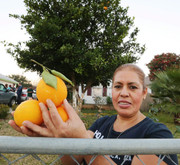
A tree that Juana Delgado grew from the seed of a grocery store orange has become a miracle on 15th Street.
This month, Delgado’s family has harvested an estimated 600 oranges from the tree she planted 15 years ago when she moved into the Habitat for Humanity home near North 15th Street and Colcord Avenue.
In recent weeks, the family made big jugs of orange juice, shared fruit with passing vagrants and sent their children door-to-door to give away large bags of juicy oranges.
The tree has defied the conventional wisdom that oranges can't survive the Central Texas winter, when temperatures usually dip into the low 20s.
But the tree has soldiered on, even through a January 2010 cold snap when temperatures plummeted to 8 degrees.
"Many people said it’s not possible," Delgado said in Spanish. "I say, 'Come look. It's possible.'"
Mark Barnett, a McLennan County master gardener and a landscaper by trade, said he has seen many people try to grow citrus trees they bought from big box stores, but the trees usually freeze and die.
"It's very unusual for it to have survived that long without protection," he said. "We've had some extremely cold winters that should have killed it."
Delgado started the orange tree in a pot using a seed from an orange she bought at an H-E-B supermarket. Most table oranges are improved hybrid varieties and tend not to reproduce faithfully by seed, Barnett said.
But Delgado's oranges turned out sweet and flavorful. Delgado has been harvesting a few oranges a year during the last decade but got her first big harvest two winters ago: A basket and a box full. In the 2011 drought, she kept the tree alive by watering it but ended up with only three oranges that season.
This year, she hit the jackpot. Her children and grandchildren climbed ladders to pick the fruit and filled six boxes with about 100 oranges each.
https://www.wacotrib.com/news/north-waco-family-s-orange-tree-a-miracle-on-th/article_3928e5be-b811-52ef-8dee-465b5788e6ae.html
________________________________________________________________
Waco, Texas, is in zone 8a, and is just a little south of Dallas. Although in recent years the 8b zone has been moving north, first the southern half of Waco was reclassified into zone 8b, and now on the latest maps zone 8b has engulfed the entire city.
I've also speculated in another thread that citrus grown from seed may have more cold hardiness in zone 8 than the usual citrus on rootstock. (This doesn't necessarily apply in zone 7 though)
So now you know there's some hope an orange tree may be able to survive in zone 8. But don't get your hopes up because this is zone 8 in the American South and Texas. All the heat during the growing season (mostly because the growing season is longer) helps the citrus put on a lot of growth and better recover from the Winter. And there may be the odd year once in a while, with an exceptionally cold Winter, where your tree is going to killed to the ground. That's the type of climate that exists in the Southeast and Gulf Coast.
But now going back to the original topic. Are there any type of Oranges that are more hardy? Or are there any orange-like citrus that are more hardy?
The only actual orange that I'm aware of that has a good chance of surviving in zone 8a is Chinotto orange. It's actually more of a sour orange, the type good for making marmalade. You can eat it, but it's not as good eating quality as a regular orange.
Then there is Bloomsweet grapefruit. It's not really a "real" grapefruit. In form and flavor it's more like something halfway between an orange and grapefruit. The eating quality isn't bad but the eating quality isn't really quite as good as the oranges or grapefruits you can find in a supermarket, and it is full of seeds. (It is believed Bloomsweet may have come from a variety in Japan named "kinkoji", and a genetic analysis has shown it to be half-sibling to the popular variety Satsuma)
Tangelos have more cold hardiness than oranges. I'm not saying a tangelo is going to grow well in zone 8a, but it's probably going to have a much better chance than orange. Minneola tangelo has great flavor, but Orlando tangelo is known to have slightly better cold hardiness than Minneola.
In general, mandarins (sometimes called "mandarin orange") are more cold hardy than oranges. Not incredibly cold hardy, but mandarins can be commercially grown on the border between zone 9a/8b.
If you're interested in juicing, FF-6-15-150 is a newer one that came out of a USDA breeding program in Florida, and is rated to be as hardy as the cold hardiest commercial mandarin varieties. It was in large part bred from Orlando tangelo, is said to have great flavor, though seedy and on the small side for an orange. But it's not commonly available to the public and may be difficult to get your hands on.
Calamondin is believed to have originated from hybridization between kumquat and orange. It has more cold hardiness than orange, can grow in zone 8b, and has a chance of growing in zone 8a (maybe not as well). Mandarinquat is similar, it's a hybrid between kumquat and mandarin, and has slightly more cold hardiness than calamondin. The inside flesh of a mandarinquat is better than a kumquat, but although it can be eaten like a kumquat, the skin is a little bit tougher and not as good. And of course this section wouldn't be complete without making quick mention to Nippon Orangequat (a hybrid between kumquat and Satsuma mandarin). It has the best chance of doing well in zone 8.
Changsha mandarin and Citrange (a cross between Orange and bitter Trifoliate Orange) are two more pretty cold hardy ones that are distantly orange-like, sort of, if you're willing to drastically lower your expectations of fruit quality and flavor.
There are many other citrus varieties that have more cold hardiness but none of them are really "orange-like", so we won't really go into that discussion here.
Some of you living in zone 8 may be wondering if it's possible to grow an orange tree outside, or whether there's any kind of orange tree hardy down to zone 8a.
Well first, let me explain something. The most common citrus that people normally want to grow, oranges, regular lemons and limes, these are some of the least cold hardy citrus varieties. It's no wonder then that there's a common perception that citrus doesn't grow in zone 8, because normally when people have tried growing citrus, these are the types they have tried.
Now, before I explain further, I would like to share an optimistic story with you.
________________________________________________________________
North Waco family's orange tree a miracle on 15th Street
by J.B. Smith, January 2013

A tree that Juana Delgado grew from the seed of a grocery store orange has become a miracle on 15th Street.
This month, Delgado’s family has harvested an estimated 600 oranges from the tree she planted 15 years ago when she moved into the Habitat for Humanity home near North 15th Street and Colcord Avenue.
In recent weeks, the family made big jugs of orange juice, shared fruit with passing vagrants and sent their children door-to-door to give away large bags of juicy oranges.
The tree has defied the conventional wisdom that oranges can't survive the Central Texas winter, when temperatures usually dip into the low 20s.
But the tree has soldiered on, even through a January 2010 cold snap when temperatures plummeted to 8 degrees.
"Many people said it’s not possible," Delgado said in Spanish. "I say, 'Come look. It's possible.'"
Mark Barnett, a McLennan County master gardener and a landscaper by trade, said he has seen many people try to grow citrus trees they bought from big box stores, but the trees usually freeze and die.
"It's very unusual for it to have survived that long without protection," he said. "We've had some extremely cold winters that should have killed it."
Delgado started the orange tree in a pot using a seed from an orange she bought at an H-E-B supermarket. Most table oranges are improved hybrid varieties and tend not to reproduce faithfully by seed, Barnett said.
But Delgado's oranges turned out sweet and flavorful. Delgado has been harvesting a few oranges a year during the last decade but got her first big harvest two winters ago: A basket and a box full. In the 2011 drought, she kept the tree alive by watering it but ended up with only three oranges that season.
This year, she hit the jackpot. Her children and grandchildren climbed ladders to pick the fruit and filled six boxes with about 100 oranges each.
https://www.wacotrib.com/news/north-waco-family-s-orange-tree-a-miracle-on-th/article_3928e5be-b811-52ef-8dee-465b5788e6ae.html
________________________________________________________________
Waco, Texas, is in zone 8a, and is just a little south of Dallas. Although in recent years the 8b zone has been moving north, first the southern half of Waco was reclassified into zone 8b, and now on the latest maps zone 8b has engulfed the entire city.
I've also speculated in another thread that citrus grown from seed may have more cold hardiness in zone 8 than the usual citrus on rootstock. (This doesn't necessarily apply in zone 7 though)
So now you know there's some hope an orange tree may be able to survive in zone 8. But don't get your hopes up because this is zone 8 in the American South and Texas. All the heat during the growing season (mostly because the growing season is longer) helps the citrus put on a lot of growth and better recover from the Winter. And there may be the odd year once in a while, with an exceptionally cold Winter, where your tree is going to killed to the ground. That's the type of climate that exists in the Southeast and Gulf Coast.
But now going back to the original topic. Are there any type of Oranges that are more hardy? Or are there any orange-like citrus that are more hardy?
The only actual orange that I'm aware of that has a good chance of surviving in zone 8a is Chinotto orange. It's actually more of a sour orange, the type good for making marmalade. You can eat it, but it's not as good eating quality as a regular orange.
Then there is Bloomsweet grapefruit. It's not really a "real" grapefruit. In form and flavor it's more like something halfway between an orange and grapefruit. The eating quality isn't bad but the eating quality isn't really quite as good as the oranges or grapefruits you can find in a supermarket, and it is full of seeds. (It is believed Bloomsweet may have come from a variety in Japan named "kinkoji", and a genetic analysis has shown it to be half-sibling to the popular variety Satsuma)
Tangelos have more cold hardiness than oranges. I'm not saying a tangelo is going to grow well in zone 8a, but it's probably going to have a much better chance than orange. Minneola tangelo has great flavor, but Orlando tangelo is known to have slightly better cold hardiness than Minneola.
In general, mandarins (sometimes called "mandarin orange") are more cold hardy than oranges. Not incredibly cold hardy, but mandarins can be commercially grown on the border between zone 9a/8b.
If you're interested in juicing, FF-6-15-150 is a newer one that came out of a USDA breeding program in Florida, and is rated to be as hardy as the cold hardiest commercial mandarin varieties. It was in large part bred from Orlando tangelo, is said to have great flavor, though seedy and on the small side for an orange. But it's not commonly available to the public and may be difficult to get your hands on.
Calamondin is believed to have originated from hybridization between kumquat and orange. It has more cold hardiness than orange, can grow in zone 8b, and has a chance of growing in zone 8a (maybe not as well). Mandarinquat is similar, it's a hybrid between kumquat and mandarin, and has slightly more cold hardiness than calamondin. The inside flesh of a mandarinquat is better than a kumquat, but although it can be eaten like a kumquat, the skin is a little bit tougher and not as good. And of course this section wouldn't be complete without making quick mention to Nippon Orangequat (a hybrid between kumquat and Satsuma mandarin). It has the best chance of doing well in zone 8.
Changsha mandarin and Citrange (a cross between Orange and bitter Trifoliate Orange) are two more pretty cold hardy ones that are distantly orange-like, sort of, if you're willing to drastically lower your expectations of fruit quality and flavor.
There are many other citrus varieties that have more cold hardiness but none of them are really "orange-like", so we won't really go into that discussion here.
48
Cold Hardy Citrus / Grapefruit that grows outside in England
« on: September 17, 2018, 01:27:39 PM »
There is a grapefruit tree growing outdoors, and which produces fruit, in the Chelsea Physic Garden, located in London.
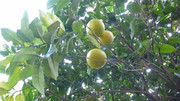


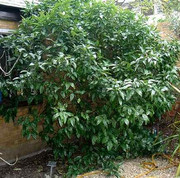
A little bit of information about this grapefruit, it started off as a seedling sown in 1948 and kept in a pot until 1990, when the original owner died. It has fruited regularly every year since 1998.
It has been nick-named 'Aunt Queenie'.
The tree is located in a sheltered corner up against a brick wall under the protection of a large olive tree, and produces regular crops of large yellow fruits that hang for months on its branches.
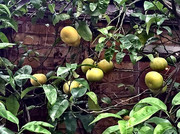


With the thick pith and small fruit size, it doesn't look like those fruits are ripening very well in the cool climate.
A couple of possible factors that may be contributing to it being able to grow so far North: it is located in the center of a large city which probably has an effect on the localized climate, the garden is located next to the Thames river which may be having a moderating effect on the nearby temperature, the tree is growing in the corner of a sheltered walled garden. The fact that it was grown from seed and is not grafted onto a different rootstock might also be making the plant more vigorous and resilient to the cold. Since it is a white grapefruit, the variety it was sown from was most likely Duncan or Marsh, which are a bit more hardy than other common grapefruit varieties.




A little bit of information about this grapefruit, it started off as a seedling sown in 1948 and kept in a pot until 1990, when the original owner died. It has fruited regularly every year since 1998.
It has been nick-named 'Aunt Queenie'.
The tree is located in a sheltered corner up against a brick wall under the protection of a large olive tree, and produces regular crops of large yellow fruits that hang for months on its branches.



With the thick pith and small fruit size, it doesn't look like those fruits are ripening very well in the cool climate.
A couple of possible factors that may be contributing to it being able to grow so far North: it is located in the center of a large city which probably has an effect on the localized climate, the garden is located next to the Thames river which may be having a moderating effect on the nearby temperature, the tree is growing in the corner of a sheltered walled garden. The fact that it was grown from seed and is not grafted onto a different rootstock might also be making the plant more vigorous and resilient to the cold. Since it is a white grapefruit, the variety it was sown from was most likely Duncan or Marsh, which are a bit more hardy than other common grapefruit varieties.
49
Citrus General Discussion / Theory: percentage of nucellar seeds vary depending on the pollinator
« on: September 05, 2018, 06:26:09 PM »
I have theory. I don't have any evidence for it, but let me share the reasoning for it.
Among different citrus varieties there are some which produce a higher percentage of nucellar seeds than others. Some citrus species produce entirely zygotic seed, while other varieties produce almost entirely nucellar seed, and there are several varieties with percentages in between. If the seed is nucellar, it will be a genetic clone of its parent. Not really a good thing if you're trying to hybridize new citrus varieties, but a good thing for those growing rootstock from seed, where uniformity is important.
The reason, it is believed, some citrus varieties form nucellar seed is that the sexual gamete cells inside the seed are not vigorous enough and can't compete with the nucellar cells.
The original origin citrus species are, almost entirely without exception, all zygotic. But when different citrus species are hybridized the percentages of nucellar seed shoot up. This could be because the hybridization between different species (which are not entirely compatible) results in a weaker gamete (megagametophyte), and so the nucellar lining takes over.
My theory is that if a hybrid citrus flower is pollinated with pollen from one of the original two species from which the hybrid originated from, the percentage of nucellar seed is likely to be lower. This would be because, the genetic composition of the megagametophyte would be less heterogenous, and thus presumably have more vigor.
So, for example, if Yuzu were pollinated by C. ichangensis, there might be some zygotic seeds form in the Yuzu fruit.
If this theory is true, this may confer some advantage to hybridizing new citrus varieties, since normally trying to hybridize a variety that is highly nucellar and using it as the female parent presents some pragmatic challenges.
Among different citrus varieties there are some which produce a higher percentage of nucellar seeds than others. Some citrus species produce entirely zygotic seed, while other varieties produce almost entirely nucellar seed, and there are several varieties with percentages in between. If the seed is nucellar, it will be a genetic clone of its parent. Not really a good thing if you're trying to hybridize new citrus varieties, but a good thing for those growing rootstock from seed, where uniformity is important.
The reason, it is believed, some citrus varieties form nucellar seed is that the sexual gamete cells inside the seed are not vigorous enough and can't compete with the nucellar cells.
The original origin citrus species are, almost entirely without exception, all zygotic. But when different citrus species are hybridized the percentages of nucellar seed shoot up. This could be because the hybridization between different species (which are not entirely compatible) results in a weaker gamete (megagametophyte), and so the nucellar lining takes over.
My theory is that if a hybrid citrus flower is pollinated with pollen from one of the original two species from which the hybrid originated from, the percentage of nucellar seed is likely to be lower. This would be because, the genetic composition of the megagametophyte would be less heterogenous, and thus presumably have more vigor.
So, for example, if Yuzu were pollinated by C. ichangensis, there might be some zygotic seeds form in the Yuzu fruit.
If this theory is true, this may confer some advantage to hybridizing new citrus varieties, since normally trying to hybridize a variety that is highly nucellar and using it as the female parent presents some pragmatic challenges.
50
Cold Hardy Citrus / How many of you here have cold-hardy citrus that was grown from seedlings?
« on: July 23, 2018, 09:26:24 AM »
How many of you here have cold-hardy citrus that you grew from seed?
I ask because this could lead to new hybrids. Seedlings don't always have the same genetic mix as their parents. Sometimes a seedling will have better tasting fruit or be more cold hardy.
It's also a simple cheap way (although time & effort intensive) to propagate more plants.
I ask because this could lead to new hybrids. Seedlings don't always have the same genetic mix as their parents. Sometimes a seedling will have better tasting fruit or be more cold hardy.
It's also a simple cheap way (although time & effort intensive) to propagate more plants.
SMF spam blocked by CleanTalk






